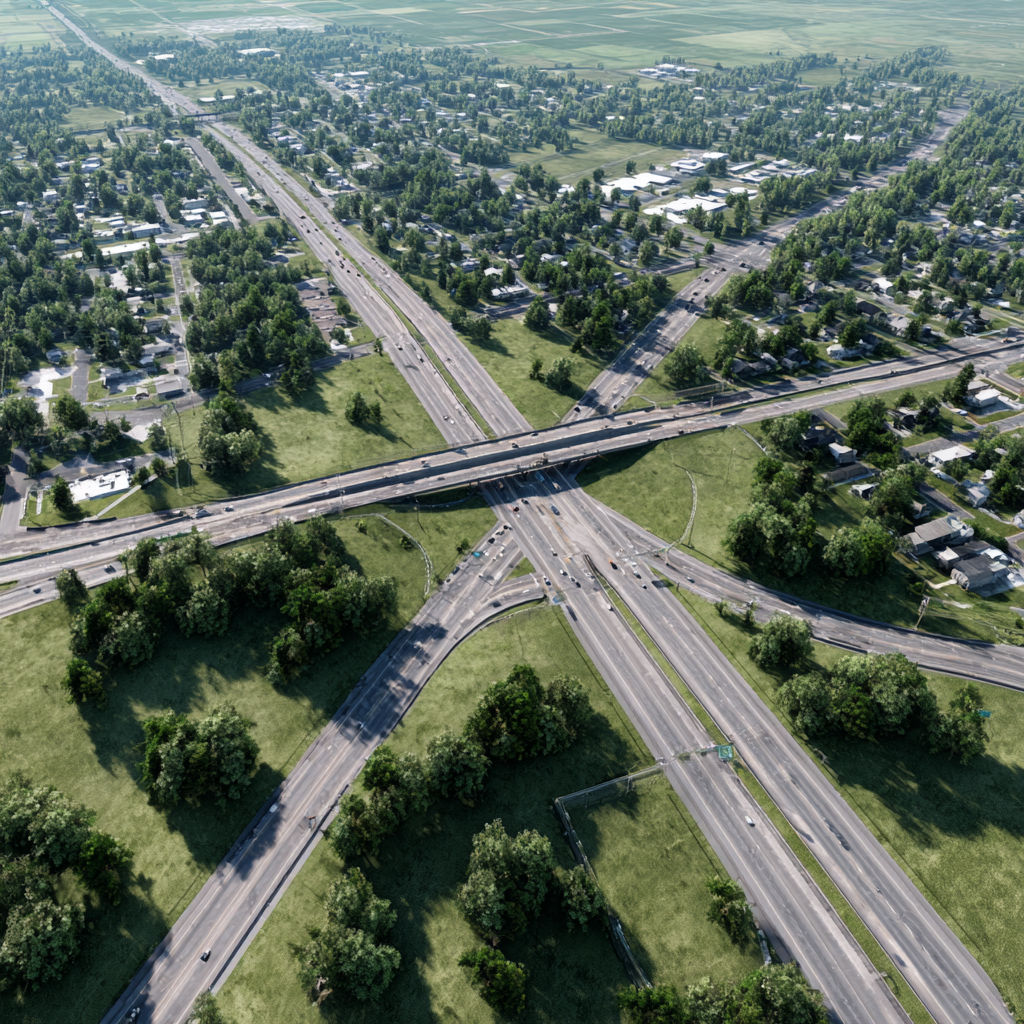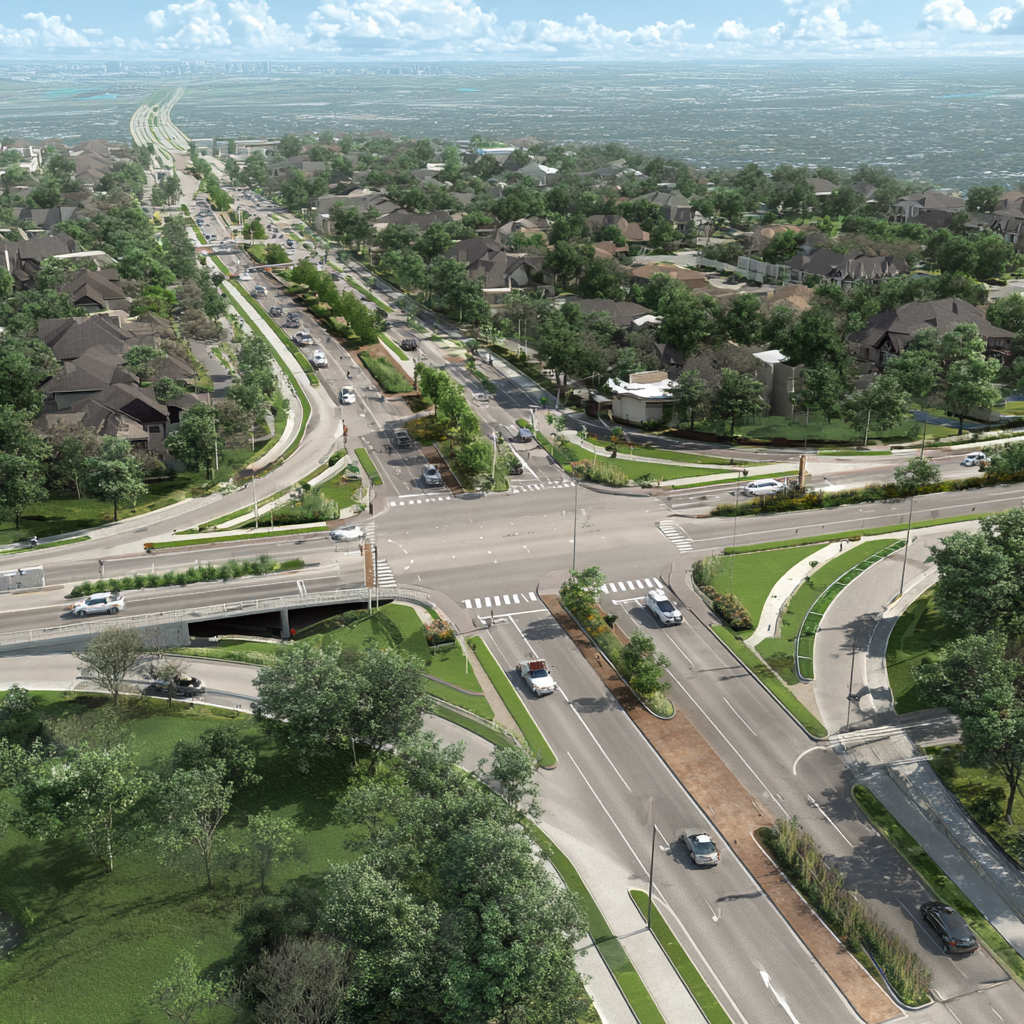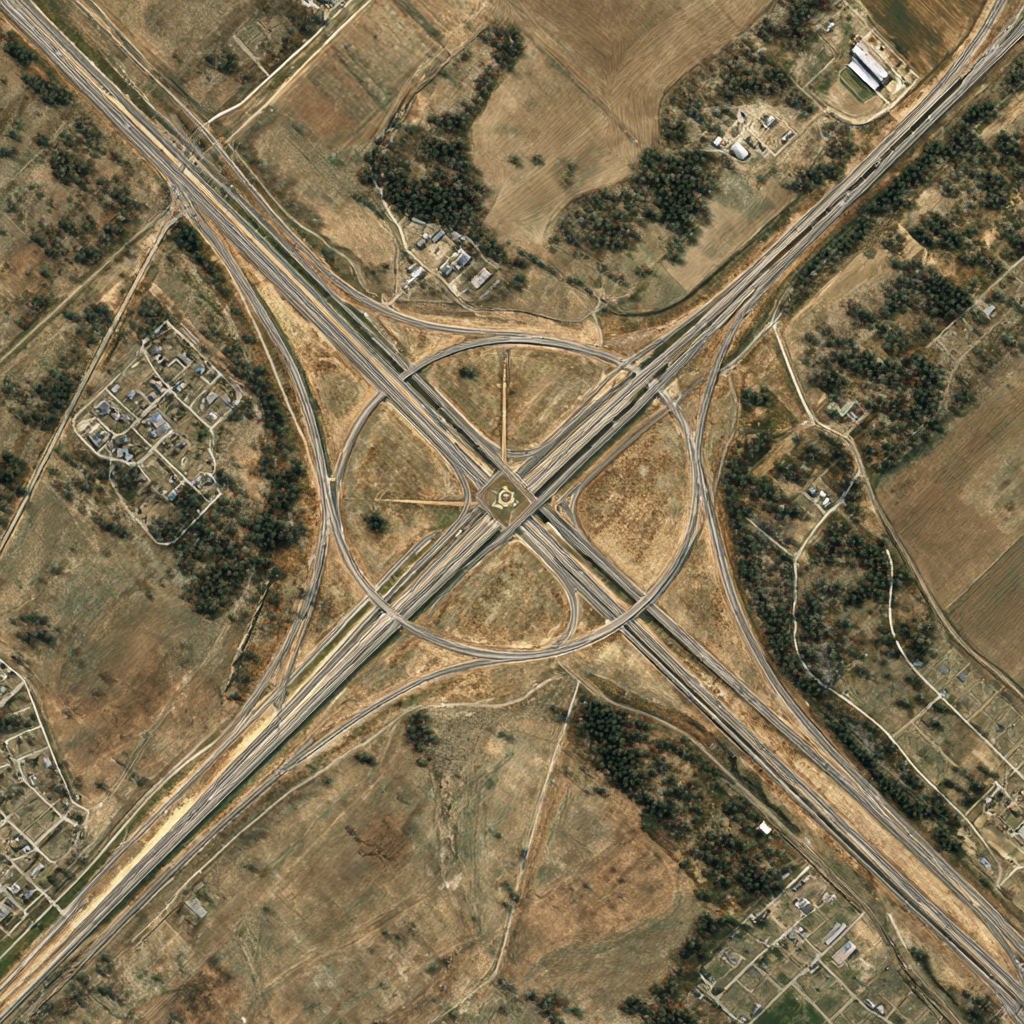Richmond, Texas has several intersections with significantly higher crash rates than others, with the most dangerous being FM 762 at I-69/US 59 Southbound Frontage Road, US 90 Alt at Williams Way, and I-69 Northbound Feeder at Reading Road.
These intersections experience the most accidents due to the combination of high-speed traffic and local roads, poor visibility, inadequate traffic controls, and Richmond’s rapid population growth, overwhelming the older road infrastructure.
The intersections we’ve identified handle complex traffic patterns where highway speeds meet local traffic signals, creating perfect conditions for serious crashes.
Many of these dangerous spots lack protected turn signals or have confusing lane configurations that catch drivers off guard.
Heavy truck traffic from industrial areas adds another layer of risk, especially during morning and evening rush hours when commuter traffic peaks.
This guide shows you exactly where these high-crash intersections are located, why they’re so dangerous, and what steps to take if you’re involved in an accident at one of these spots.
The Most Dangerous Intersections in Richmond, Texas
Richmond’s rapid growth has created serious traffic problems at key intersections throughout the city. These crossings see the highest number of crashes due to poor design, high speeds, and heavy congestion.
The most dangerous spots handle traffic from major highways, mixing with local roads. This creates a perfect storm for accidents when drivers don’t adjust their speed or fail to yield properly.
According to the Texas Department of Transportation, Fort Bend County experienced 11,549 total crashes in 2023, resulting in 43 fatalities and 4,379 injuries.
US 90 Alt Corridor Intersections

US 90 Alt serves as Richmond’s main east-west route, carrying both local traffic and drivers passing through the area. The high speeds and constant traffic flow make these intersections particularly dangerous.
US 90 Alt at Williams Way ranks as one of the most hazardous spots in Richmond. Drivers often misjudge the speed of oncoming traffic when making left turns. The intersection lacks protected turn signals, forcing drivers to find gaps in fast-moving traffic.
US 90 Alt at FM 762 (Thompson Road) sees frequent multi-car accidents during rush hour, especially rear-end and angle crashes. Many accidents happen when drivers following too closely can’t stop in time for red lights.
FM 359 Corridor Intersections

FM 359 connects Richmond to Sugar Land, Fulshear, and other growing communities. This makes it one of the busiest commuter routes in Fort Bend County.
FM 359 at Mason Road is notorious for left-turn crashes. Drivers turning left often fail to yield to oncoming traffic or misjudge gaps in the flow. The intersection handles heavy traffic in all directions during peak hours.
FM 359 at FM 723 creates problems when drivers engage in reckless driving behaviors, such as speeding through yellow lights or running red lights. The long stretches between signals encourage higher speeds, making crashes more severe.
FM 762 And I 69 Feeder Intersections

These intersections are dangerous because they mix highway traffic with local roads. Drivers exiting I-69 often maintain highway speeds while local traffic moves much more slowly.
FM 762 at I-69/US 59 Southbound Frontage Road handles complex traffic patterns as drivers enter and exit the highway. Many crashes involve unsafe lane changes and failure to yield right-of-way. The multiple lanes and merging traffic confuse drivers unfamiliar with the area.
I-69/US 59 Northbound Feeder at Reading Road sees frequent merging collisions. Drivers struggle to navigate the transition from highway speeds to local traffic signals.
FM 2218 And B F Terry Boulevard Intersections
This corridor runs through Richmond’s commercial heart, creating unpredictable traffic patterns. Shopping centers and restaurants generate constant turning movements throughout the day.
FM 2218 (B.F. Terry Blvd) at Reading Road experiences crashes linked to distracted driving near retail areas. Drivers focus on finding parking or reading store signs instead of watching traffic signals.
SH 99 Interchanges Near Richmond

The Grand Parkway (SH 99) is a high-speed toll road where drivers must navigate complex lane changes and merging situations. Many drivers are unfamiliar with these newer interchanges.
SH 99 at Harlem Road creates confusion with its multiple lanes and unclear signage. Drivers often find themselves in the wrong lane at the last second, leading to dangerous sideswipe crashes.
Why These Richmond Intersections See So Many Crashes
Several factors combine to make these specific intersections so dangerous for Richmond drivers. Understanding these causes helps you stay more alert when approaching these areas.
Rapid Population Growth
Rapid population growth has overwhelmed Richmond’s road system. Many intersections were designed decades ago for much lighter traffic volumes. The infrastructure simply can’t handle today’s traffic safely.
Speed Transitions
Speed transitions create significant hazards when highways meet local roads. Drivers exiting I-69 or SH 99 sometimes approach intersections at speeds that are much higher than the posted limits for local roads, creating a risk when transitioning from highway to city traffic.
Heavy Truck Traffic
Heavy truck traffic adds another layer of danger throughout Richmond. The area’s industrial zones bring constant 18-wheeler traffic through residential intersections. These large vehicles have massive blind spots and need much longer stopping distances.
Poor Visibility
Poor visibility plagues many older intersections in Richmond. Trees, buildings, or inadequate lighting prevent drivers from seeing approaching traffic clearly. This becomes especially dangerous during dawn and dusk hours.
Inadequate Traffic Controls
Inadequate traffic controls leave drivers guessing about right-of-way rules. Many high-crash intersections lack protected left-turn signals or have confusing signal timing that encourages risky behavior.
How We Built The Richmond Intersection Hotspot List
We created this list using official crash data from multiple reliable sources. Our goal was to give you accurate, factual information about where accidents actually happen most often.
The Texas Department of Transportation maintains detailed crash records through their CRIS database. We reviewed this data alongside reports from Fort Bend County Sheriff’s Office and Richmond Police Department.
Our analysis focused on intersections with the highest rates of injury and fatal crashes rather than minor fender-benders.
We updated our research annually to ensure the information stays current. Traffic patterns change as Richmond grows, so what was once a safe intersection may become a danger zone tomorrow.
For immediate legal assistance regarding a car accident and to understand your rights, contact Vendt Accident Attorneys for a free consultation.
How To Drive Safer At Richmond And Fort Bend Intersections
You can’t control other drivers, but you can protect yourself by adopting defensive habits at these known trouble spots. Smart driving techniques significantly reduce your crash risk.
Even careful drivers can become victims of someone else’s negligence, but these strategies help:
Slow down before major intersections:
Reduce speed even with green lights, especially at US 90 Alt crossings
Look twice for red-light runners:
Pause after the lights turn green and scan both directions
Increase following distance:
Stay extra far behind trucks that can block your view of signals
Avoid distractions:
Put phones away completely when approaching I-69 feeder intersections
Use extra caution during rush hours:
Morning and evening commutes see the highest crash rates
The reality is that intersection accidents in Richmond, TX, can happen despite your best efforts. Another driver’s split-second mistake can change your life forever.
What To Do After An Intersection Accident In Richmond TX
The moments after a crash feel chaotic and overwhelming. Your actions during this critical time protect both your health and your legal rights.
Staying calm and following the proper steps can make a huge difference in your recovery and any insurance claim. Here’s exactly what you need to do.
Call 911 And Seek Medical Care
Your safety comes first, always. Call 911 immediately to report the crash and request medical help if anyone appears injured.
Richmond Police or Fort Bend County Sheriff’s deputies will respond to document the scene. Accept medical evaluation from paramedics even if you feel fine – serious injuries like concussions or internal bleeding don’t always show symptoms right away.
OakBend Medical Center and other nearby hospitals can provide emergency treatment. Don’t refuse medical care to avoid ambulance costs – your health is worth more than any bill.
Document The Scene And Vehicles
If you’re physically able, use your phone to photograph everything at the crash scene. Take pictures from multiple angles showing vehicle damage, skid marks, traffic signals, and street signs.
Capture the intersection name and cross streets clearly in your photos. Document any debris, fluid spills, or property damage beyond the vehicles involved.
These photos become crucial evidence later when insurance companies try to dispute what happened. Take more pictures than you think you need.
Exchange Information Without Admitting Fault
Stay calm while exchanging contact and insurance information with the other driver. Get their full name, phone number, insurance company, and policy number.
Don’t say “I’m sorry” or talk about who was to blame. Later on, insurance companies may use these statements against you. Don’t guess who caused the crash; just stick to the facts of what you saw.
If the other driver appears aggressive or intoxicated, maintain a safe distance and let the police handle all communication.
Preserve Video And Traffic Camera Footage
Many Richmond intersections have traffic cameras, and nearby businesses often have surveillance systems. This video footage gets deleted quickly – sometimes within just a few days.
Write down the names and addresses of nearby businesses that might have cameras. Note the exact time and date of your crash for reference.
An experienced attorney can send preservation letters to ensure this critical evidence doesn’t disappear before your case is resolved.
Contact A Richmond Car Accident Attorney
Insurance companies have teams of lawyers and adjusters working to pay you as little as possible. You need experienced legal representation to level the playing field.
A local car accident attorney in Richmond, TX, understands the specific challenges of Fort Bend County roads and courts. They are aware of which intersections have ongoing safety issues and know how to construct strong cases for their clients.
Don’t wait to get legal help; necessary evidence disappears quickly, and insurance companies begin building their case immediately.
How Texas Fault And Insurance Affect Intersection Claims
Texas follows a modified comparative fault rule that directly affects how much money you can recover after a crash. This legal principle can make or break your case.
Under Texas law, if you’re found 51% or more responsible for the accident, you get nothing. If you’re less than 51% at fault, your compensation gets reduced by your percentage of blame.
For example, if you’re 20% at fault and have $100,000 in damages, you’d receive $80,000. Insurance companies are aware of this rule and will fight hard to shift the blame onto you.
Intersection crashes often involve disputed fault because multiple factors contribute to the collision. Did someone run a red light? Was the turn signal working? These details become critical in determining who pays.
Texas requires all drivers to carry minimum insurance coverage, but these limits are often too low for serious crashes. Many Richmond drivers carry higher limits due to the area’s expensive medical costs and property values.
Why Speak With A Richmond TX Car Accident Lawyer
After an intersection crash, you need someone who understands both the law and the local landscape. Generic advice from out-of-state lawyers won’t help with Fort Bend County’s unique challenges.
At Vendt Accident Attorneys, our team is dedicated to representing injured Texans with skill and commitment. We’re based right here in Richmond, not some distant city with a satellite office.
We know these dangerous intersections personally because we drive them every day. Our local knowledge enables us to build stronger cases and negotiate more favorable settlements for our clients.
Our comprehensive approach includes:
Immediate investigation: We preserve evidence before it disappears
Medical coordination: We help arrange treatment even without health insurance
Insurance negotiation: We handle all communications with adjusters
Trial preparation: We’re ready to fight in court if needed
We work on a contingency fee basis, meaning you pay nothing unless we win your case. This allows you to get quality legal representation without upfront costs during an already difficult time.
Our Richmond location means we’re always available for face-to-face meetings. Personal relationships are crucial when dealing with life-changing injuries.
Frequently Asked Questions
How often do you update crash data for Richmond intersections?
We review and update our dangerous intersection analysis every year using the newest crash reports from TxDOT and Richmond police to keep our information current and accurate.
Where can I find official Fort Bend County crash maps?
The Texas Department of Transportation’s CRIS public query system lets anyone view detailed crash data and locations throughout Fort Bend County and Richmond online.
How do I report a dangerous intersection to Richmond authorities?
Contact Richmond’s Public Works Department directly to report safety concerns about specific intersections – they can evaluate locations for potential traffic signal or signage improvements.
Does Richmond use red light cameras at intersections?
Richmond has limited red-light camera enforcement, mainly at major US 90 Alt intersections, but many crashes get captured by nearby business surveillance systems.
What insurance pays for hit-and-run crashes at intersections?
Your own Uninsured/Underinsured Motorist coverage protects you in hit-and-run situations, which is why we strongly recommend all Richmond drivers carry UM coverage above state minimums.
What money can I recover after a Richmond intersection crash?
You can seek compensation for medical bills, lost wages, vehicle repairs, and pain and suffering – the total value depends on your injury severity and how clearly the other driver was at fault.